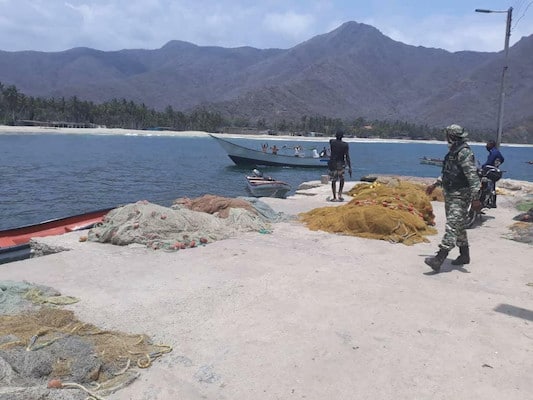What happened last Monday, May 4, on the coast of the town of Chuao, municipality of Santiago Mariño in the state of Aragua, has left a mark on the history of the Bolivarian process due to the combined action of the Bolivarian National Armed Forces and the citizenry, in particular a group of fishermen, police and members of the Bolivarian National Militia.
The image of a villager and a militiaman completing the work of a Naval Aviation helicopter gunship, which consisted of stopping the boat occupied by eight paramilitaries and capturing that crew sent by the governments of the United States and Colombia, has been incorporated into the deeds of the Chavista era as a concrete example of civic-military union.
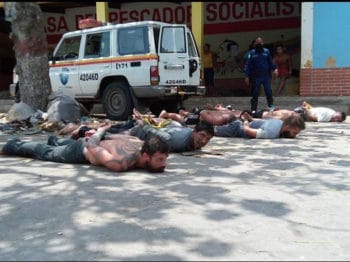
Paramilitaries financed by the U.S. and Colombian governments are captured by conventional security forces and members of the Bolivarian Militia. Photo: Twiter
The concept of this union has been fundamental in Chavista thought since its origin. It has its roots in the independence and popular struggle of the last century, since social and military factors converged in the overthrow of Marcos Pérez Jiménez.
Fabricio Ojeda, the leader of this movement who was betrayed and assassinated by the government of Raúl Leoni, incorporated it into his practice and his work La guerra del pueblo (1966) where he stated:
The anti-feudal and anti-imperialist basis of our revolutionary process poses a kind of alliance that is above the origin of political creed, philosophical conception, religious convictions, economic or professional conditions and party affiliation of Venezuelans. The common enemy, its strength and power, calls for a unitary struggle to defeat it. The following forces are ready to fight for national liberation: workers and peasants, the petty bourgeoisie, students, intellectuals, professionals, most of the officers, non-commissioned officers and soldiers of the air, sea and land forces.
A union “vital to the future of the world”
From the link between this heritage and the Bolivarian military doctrine, Hugo Chávez enriched the concept during the construction of the so-called Bolivarian Agenda, which more than a government plan has been an idea of national transformation in which the people are regarded as a great army at the service of the defence of national sovereignty and independence.
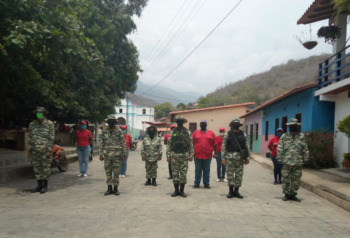
Components of the Bolivarian Militia and the people’s power organized in the town of Chuao Photo: Mónica Ávila
When he became president of Venezuela in 1999, in addition to calling for a consultative process for a National Constituent Assembly, he implemented a social care plan called Bolívar 2000 that included state institutions and the then Armed Forces (AF), which sought to shape an army that was not separated from society.
It sought to bring the people and the Armed Forces closer over the distance caused by the repression they maintained against the population throughout the Fourth Republic, particularly that ordered by the adeco government of Carlos Andrés Pérez during the popular rebellion of February 27, 1989 against neoliberal measures.
The civic-military union took shape with the creation of the Bolivarian National Militia in 2008 when the name was changed from General Command of the Military Reserve and National Mobilization (auxiliary body of the FANB created in April 2005) to General Command of the Bolivarian National Militia.
The change was implemented on April 13, 2009. That same day, in 2002, the combined mobilization of civilian and military sectors defeated the coup d’état against Chávez financed by the Bush administration and the national business community.
The essence of the people in arms
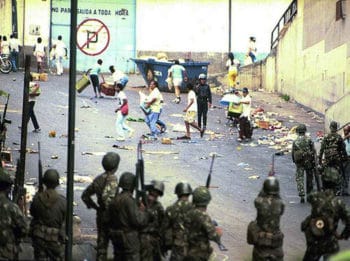
In 1989, military forces served transnational interests by massacring the population during the popular rebellion against neoliberal measures. Photo: Archives
The concept of “people in arms” is essential in the popular resistance of Venezuela against the onslaught of the transnational siege on the country. Chávez’s vision is summarized in his words during the “Aló Presidente” Program number 353, on March 14, 2010, from Cumaná, Sucre state:
The Bolivarian militias, the Bolivarian National Militia. The people must prepare for defense, the fishermen must be soldiers, but not only in word, no, trained in the use of weapons, at the time of an aggression that God does not want, but well one never knows, right? The Empire has its eyes on us, on the Bolivarian Revolution, and the Empire worries when it sees these things, you see? Because the Empire is afraid of the success of the Bolivarian project, it is afraid of it because we are showing that the development of the people is possible through socialism and not through capitalism. This is vital for the future of the world, what is happening here, we cannot fail, they will try to sabotage us as they have done, as they have done to Cuba, the blockade, that is a sabotage to the Cuban economy, they will not allow Cuba to develop the economy, they have had Cuba, they have wanted to drown Cuba, only Cuba resisted, is resisting and now with more reason, in the Dawn, the Bolivarian Alliance.
One of the important aspects in the concept that the Bolivarian leader implemented is the presence of the Militia in the key facets of national development, hence it is organized in each field, university, factory or neighbourhood.
This is a strategic military concept, but also a social and political one, for the integral defence of the nation, as important as the antiaircraft defence system or the naval fleet, based on the voluntary participation of the citizens, in the responsibility of defending social guarantees.
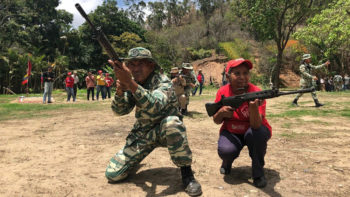
The strategic military concept for the integral defence of the nation includes men and women, young and old in every field, university, factory or neighbourhood. Photo: Sputnik
The organization and incorporation of the “people in arms” to the national defense pursues integrality to preserve sovereignty and peace in the territory.
“It is the people in arms, the war of all the people (…) We have no plans to attack, but we are going to turn Venezuela into a country capable of defending every last inch of its territory, and for that purpose the participation of the people is important,” explained Chávez on that occasion.
Growing expression of the organized people
The Bolivarian National Militia, which has its own General Command and General Staff, depends on the Strategic Operational Command linked to the FANB’s Chief Command (CEOFANB).
It consists of the National Reserve, made up of all Venezuelan citizens who are not in active military service, and the militias themselves, made up of the Territorial Militia and the Combatant Corps. Its basic element is the Unidad Popular de Defensa Integral (UPDI).
The members of the Territorial Militia gather on weekends to receive military instruction, during the week they carry out various activities and may be called upon to gather in case of need in the face of other extraordinary occasions or emergencies.
This includes the so-called Rural or Peasant Militia, whose weapons and equipment are different from those of the rest of the force. The leadership of each Territorial Militia is made up of officers trained within the militia and reservists.
The Combatant Corps is made up of workers or retirees from certain institutions and public or private companies, and is responsible for ensuring its integrity and operability with a minimum of personnel. They are assembled once a month.
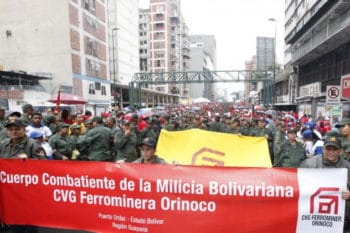
The Combatant Corps protects Guyana’s basic businesses and, with them, national production, which is under attack by global right-wing extremism. Photo: Archive
On January 29, the National Constituent Assembly (ANC) approved the Constitutional Law of the Bolivarian National Armed Force (FANB) promoted by President Nicolás Maduro since November 2019.
In this regard, Defense Minister Vladimir Padrino López stressed that “it has incorporated new concepts, such as the Territorial Defense System, Integral Defense and the Civil-Military Union; the latter is not a cliché, it is a principle, the basis of co-responsibility to guarantee freedom and national independence.
With this, he alluded to Article 59 of the law that incorporates the Bolivarian Militia as a component of the FANB (which until then was made up of the Army, Navy, Aviation and National Guard).
Last April, the Militia reached 4,156,567 registered militiamen, incorporated and trained under the Tactical Method of Revolutionary Resistance. They are deployed throughout the national territory in 1,165 People’s Integral Defense Groups (APDI), 14,383 People’s Integral Defense Bases (BPDI) and 50,459 People’s Integral Defense Units (UPDI).
Moralization and Countercoup
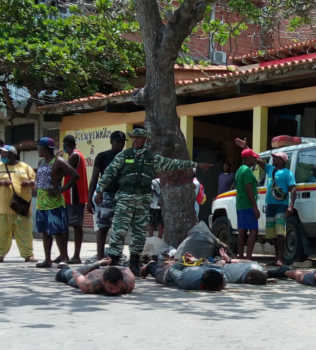
The civil-military union had a high profile in the events in Chuao in recent days against “Operation Gideon”. Photo: Mónica Ávila
The Chuao people, who have resisted 400 years of attempts at domination and acculturation, are today the focus of the anti-imperialist struggle in Venezuela and are highly symbolic. In this case the common enemy for civilians and military is the one who renounced politics and the peaceful exercise of rights because of aggression and the seizure of rights from a country under siege.
The transnational elites do not have an armed force kneeling at the feet of their interests in Venezuela, so they resort to hiring mercenaries for their assassination and coup d’état objectives, which a brave community has peacefully but firmly neutralized.
The episodes that have put the Venezuelan population in the vanguard of the events, based on popular intelligence and organization, have shown once again that the Chavista conception of “people in arms” is not mere rhetoric but a doctrine of praxis capable of disrupting attempts at political and military destabilization against the country.
- Second Mercenary Incursion Against Venezuela in 48 Hours Fails in Chuao
- Venezuelan Version of the Bay of Pigs: Anatomy of “Operation Gideon”
- Macuto: A New Frustrated Chapter in the War Against Venezuela

